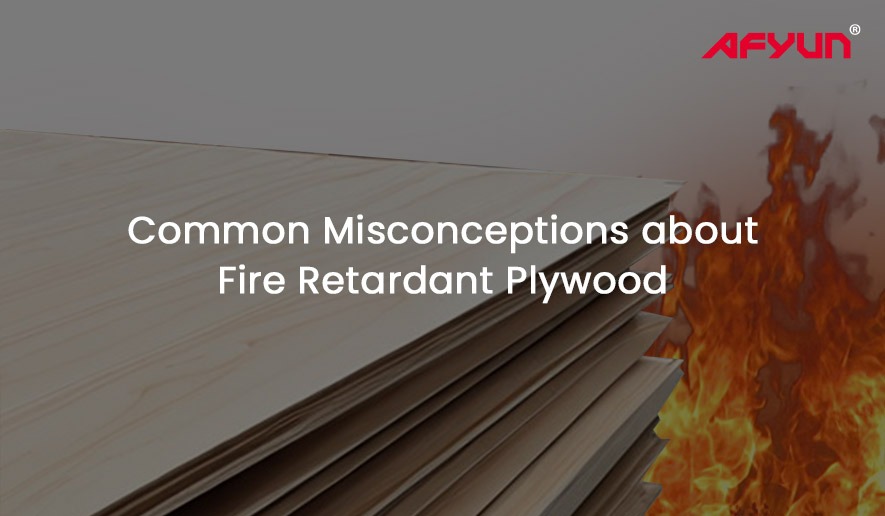Fire retardant plywood is a specialized type of plywood that has been treated with chemicals to enhance its fire resistance properties.
While fire retardant plywood offers several benefits and is widely used in various construction and interior applications, there are also common misconceptions surrounding its usage.
In this blog, we will address some of these misconceptions and provide clarity on fire-retardant plywood.
Misconception 1: Fire Retardant Plywood is Fireproof
One of the most common misconceptions about fire retardant plywood is that it is fireproof. However, this is not entirely accurate. Fire retardant plywood is designed to resist the spread of flames and slow down the burning process in the event of a fire.
The fire retardant chemicals used in the treatment of the plywood work by reducing the rate at which the plywood ignites and limiting the spread of fire.
It is important to understand that while fire retardant plywood offers improved fire resistance compared to untreated plywood, it is not completely immune to fire. The level of fire resistance may vary depending on the specific treatment and the duration and intensity of the fire.
Therefore, it is crucial to adhere to fire safety regulations, implement proper fire prevention measures, and use fire retardant plywood in conjunction with other fire protection systems for maximum safety.
Misconception 2: Fire Retardant Plywood is Toxic
Another misconception about fire retardant plywood is that it is toxic and emits harmful fumes when exposed to fire. While it is true that fire retardant plywood contains chemicals that provide fire resistance, modern manufacturing processes have significantly reduced the toxicity associated with these products.
Fire retardant plywood undergoes rigorous testing and certification procedures to ensure compliance with safety standards and regulations.
Manufacturers use chemicals that are specifically chosen for their effectiveness in enhancing fire resistance while minimizing potential health risks. These chemicals are designed to withstand high temperatures and prevent the release of harmful gases.
When using fire retardant plywood in construction or interior applications, it is crucial to follow proper installation guidelines and ventilation practices. Adequate ventilation helps dissipate any potential odors or gases that may be emitted during a fire.
Misconception 3: Fire Retardant Plywood Requires Special Handling
Some people believe that fire retardant plywood requires special handling or maintenance compared to regular plywood. However, this is not the case. Fire retardant plywood can be handled and installed in a manner similar to standard plywood.
It is important to note that fire retardant plywood should be stored in a dry and well-ventilated area to prevent moisture absorption, which can affect its fire resistance properties.
Additionally, during installation, it is essential to follow standard construction practices, including proper fastening techniques and sealing of edges to maintain the integrity of the fire retardant treatment.
Misconception 4: Fire Retardant Plywood is Cost-Prohibitive
Some individuals assume that fire retardant plywood is significantly more expensive than regular plywood, leading to the misconception that it is cost-prohibitive.
While fire retardant plywood may have a slightly higher upfront cost compared to untreated plywood, it is important to consider the long-term benefits and potential cost savings associated with improved fire resistance.
In certain applications, such as commercial buildings, public spaces, or areas with specific fire safety regulations, the use of fire retardant plywood is often mandated by building codes.
By incorporating fire retardant plywood from the outset, the need for additional fire protection measures, such as fire-resistant coatings or treatments, may be reduced or eliminated. This can help in cost savings in the long run.
Conclusion
Fire retardant plywood is a valuable construction material that offers enhanced fire resistance properties. By addressing common misconceptions about fire retardant plywood, we can better understand its capabilities and limitations.
While fire retardant plywood is not fireproof, it provides improved fire resistance compared to untreated plywood. Modern manufacturing processes have significantly reduced the toxicity associated with fire-retardant plywood, making it safe for use.
Incorporating fire retardant plywood in construction and interior applications can contribute to enhanced fire safety and peace of mind.
When buying plywood, it is crucial to choose high-quality fire retardant options. Afyun Plywood provides various types of plywood types, such as
Whether for bed frames, interior applications, or other needs, Afyun has you covered.
You May Also Like:
Plywood Price | Plywood Price in India | Calibrated Plywood Price | Gurjan Plywood Price | Fire Retardant Plywood Price | Waterproof Plywood Price | Marine Plywood Price








